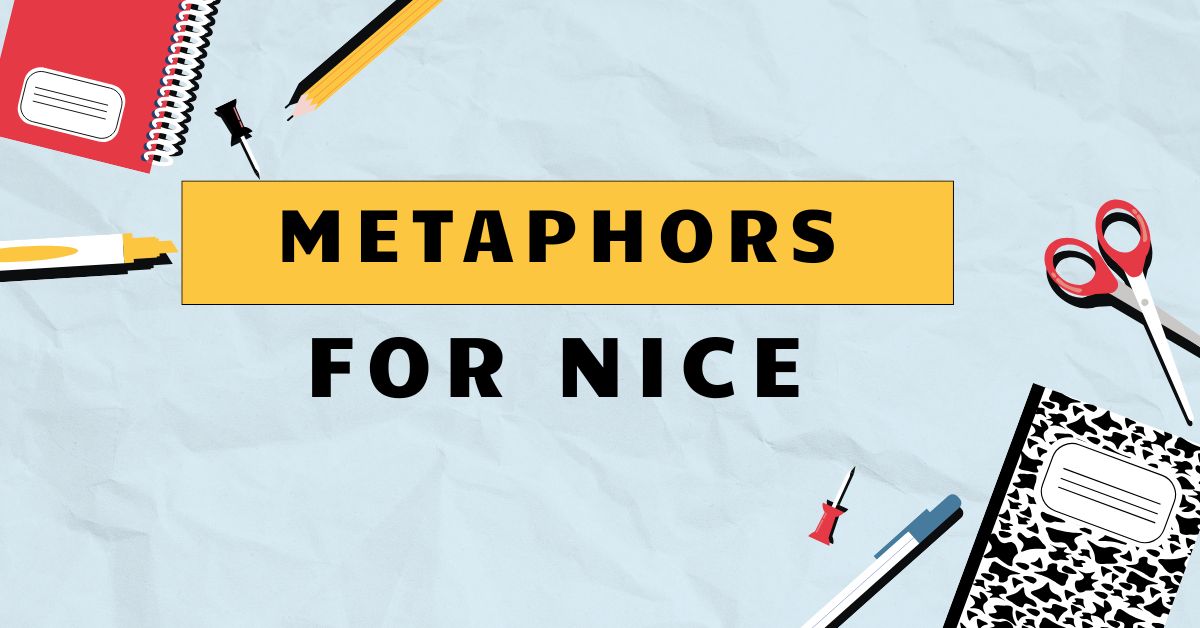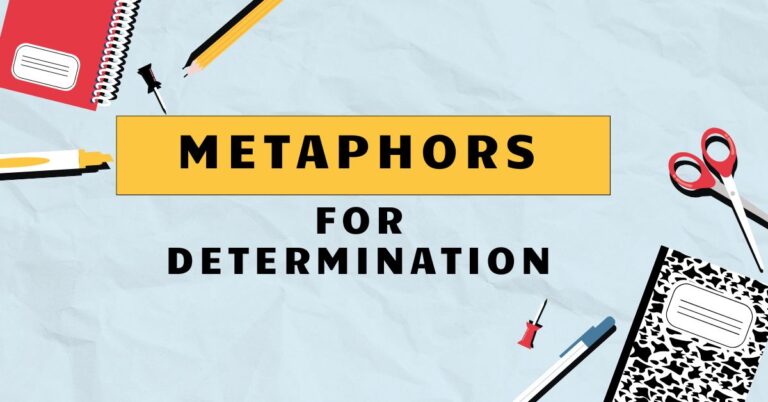41 Metaphors for Nice: Expanding Your English Vocabulary
Understanding metaphors for the word “nice” is crucial for enhancing your English vocabulary and improving your ability to express subtle nuances in communication. “Nice,” while a common adjective, can often lack the depth and specificity needed to convey the true nature of a person, object, or experience.
By exploring a range of metaphors, learners can enrich their language skills, making their expressions more vivid, engaging, and precise. This article is designed for English language learners of all levels, from beginners seeking to add variety to their vocabulary to advanced speakers aiming to refine their expressive capabilities.
It will cover definitions, structural breakdowns, types of metaphors, usage rules, common mistakes, practice exercises, and advanced topics to provide a comprehensive understanding of this essential aspect of English grammar.
Table of Contents
- Introduction
- Definition of Metaphor and “Nice”
- Structural Breakdown of Metaphors
- Types of Metaphors for “Nice”
- Examples of Metaphors for “Nice”
- Usage Rules for Metaphors
- Common Mistakes When Using Metaphors
- Practice Exercises
- Advanced Topics in Metaphorical Language
- Frequently Asked Questions
- Conclusion
Definition of Metaphor and “Nice”
Ametaphoris a figure of speech that directly compares two unrelated things. Unlike similes, which use “like” or “as” to make a comparison, metaphors state that one thingisanother.
This comparison is not literal but rather suggestive, aiming to highlight a shared quality or characteristic. Metaphors add depth and color to language, making it more engaging and evocative.
They are used extensively in literature, poetry, and everyday conversation to convey complex ideas in a concise and memorable way.
The word “nice” is an adjective used to describe something or someone that is pleasing, agreeable, or satisfactory. However, “nice” can often be seen as bland or lacking specificity.
It doesn’t always fully capture the unique qualities that make something or someone appealing. Therefore, using metaphors in place of “nice” can provide a more vivid and nuanced description.
Structural Breakdown of Metaphors
Metaphors operate by transferring qualities from one concept (thesource) to another (thetarget). Understanding this transfer process is key to effectively using and interpreting metaphors.
The source provides the characteristics that are attributed to the target, creating a new understanding of the target. The success of a metaphor depends on the strength and clarity of the connection between the source and the target.
For example, if we say “He is a lion in battle,” the source is “lion” and the target is “he.” The qualities of a lion, such as bravery and strength, are transferred to the person, suggesting that he is courageous and powerful in battle. This simple structure allows for an infinite amount of creative expression.
Types of Metaphors for “Nice”
When looking for metaphors to replace “nice,” it’s helpful to categorize them based on the specific aspect of niceness you want to emphasize. Here are some categories:
Metaphors Highlighting Positive Attributes
These metaphors focus on general positive qualities, such as goodness, excellence, or desirability. They often use imagery to convey a sense of overall approval and admiration.
Metaphors Emphasizing Pleasantness
These metaphors highlight the enjoyable and agreeable nature of something or someone. They often evoke sensory experiences, such as sweetness, smoothness, or warmth, to convey a sense of delight.
Metaphors Indicating Kindness and Generosity
These metaphors emphasize the caring and compassionate nature of someone. They often use imagery related to nurturing, support, or selflessness to convey a sense of empathy and goodwill.
Metaphors Suggesting Attractiveness and Charm
These metaphors highlight the appealing and captivating qualities of something or someone. They often use imagery related to beauty, elegance, or allure to convey a sense of admiration and desire.
Examples of Metaphors for “Nice”
Here are some examples of metaphors that you can use instead of “nice,” categorized by the aspects they emphasize. Each category includes a variety of metaphors to suit different contexts and preferences.
These tables provide at least 20-30 examples each, ranging from simple comparisons to more elaborate and creative expressions.
The following table illustrates metaphors emphasizing positive attributes. These substitute the general term “nice” with more specific and evocative descriptions.
| Metaphor | Explanation | Example Sentence |
|---|---|---|
| A gem | Something precious and valuable. | She’s a gem; always willing to help. |
| A treasure | Something highly valued and cherished. | This old book is a treasure. |
| A star | Someone who shines brightly and stands out. | He’s a rising star in the company. |
| A beacon | Something that guides and inspires. | Her kindness is a beacon in the community. |
| A gift | Something that is given and appreciated. | Having him in our lives is a gift. |
| Gold | Something of great worth and purity. | Her heart is pure gold. |
| A breath of fresh air | Something refreshing and revitalizing. | Your ideas are a breath of fresh air. |
| A ray of sunshine | Someone who brings joy and happiness. | She is a ray of sunshine on a cloudy day. |
| An angel | Someone exceptionally kind and virtuous. | She’s been an angel to me during this difficult time. |
| A champion | Someone who excels and defends others. | He’s a champion of human rights. |
| A marvel | Something that inspires wonder and admiration. | The engineering of this bridge is a marvel. |
| A dream | Something wonderful and ideal. | This vacation is a dream come true. |
| A force of nature | Someone with immense power and impact. | She’s a force of nature in the boardroom. |
| A rock | Someone dependable and steadfast. | He’s been my rock through thick and thin. |
| A pillar | Someone who provides strong support. | She’s a pillar of the community. |
| A light | Someone who illuminates and guides. | His wisdom is a light in our lives. |
| Music to my ears | Something very pleasing to hear. | Your offer is music to my ears. |
| A godsend | Something unexpectedly helpful or beneficial. | This scholarship is a godsend. |
| The real deal | Something authentic and genuine. | He’s the real deal when it comes to leadership. |
| One of a kind | Unique and exceptional. | She is truly one of a kind. |
| The best thing since sliced bread | An innovative and highly beneficial invention or person. | This new software is the best thing since sliced bread. |
| A diamond in the rough | Someone with great potential but lacking polish. | He’s a diamond in the rough; he just needs guidance. |
| The cream of the crop | The best of a group. | These students are the cream of the crop. |
The following table illustrates metaphors emphasizing pleasantness, focusing on agreeable and enjoyable qualities.
| Metaphor | Explanation | Example Sentence |
|---|---|---|
| A summer breeze | Something gentle and refreshing. | Her voice is like a summer breeze. |
| A warm blanket | Something comforting and reassuring. | His words were like a warm blanket on a cold night. |
| A sweet melody | Something pleasing and harmonious. | Their laughter is a sweet melody. |
| A ray of sunshine | Something that brings happiness and light. | She is a ray of sunshine in their lives. |
| A gentle rain | Something soothing and peaceful. | His presence is like a gentle rain after a drought. |
| A soft pillow | Something comfortable and supportive. | Her advice was like a soft pillow to rest on. |
| A cozy fire | Something warm and inviting. | Their home is like a cozy fire on a winter’s day. |
| A calming sea | Something serene and tranquil. | Her eyes are like a calming sea. |
| A gentle stream | Something flowing and peaceful. | Their conversation was like a gentle stream. |
| A sunny day | Something bright and cheerful. | His attitude is like a sunny day. |
| A peaceful garden | A place of tranquility and beauty. | Her mind is like a peaceful garden. |
| A happy song | Something joyful and uplifting. | Their relationship is like a happy song. |
| A pleasant dream | Something delightful and imaginative. | The evening was like a pleasant dream. |
| A smooth sail | Something easy and effortless. | The project went like a smooth sail. |
| A gentle touch | Something tender and caring. | Her words were like a gentle touch. |
| A light touch | Handling something delicately and skillfully. | He has a light touch when dealing with sensitive issues. |
| Velvet | Smooth, soft, and luxurious. | Her voice is like velvet. |
| Silk | Smooth, elegant, and refined. | His manners are like silk. |
| Honey | Sweet, golden, and delightful. | Her words are like honey to my ears. |
| A basket of kittens | Playful, cuddly, and heartwarming. | Seeing them together is like a basket of kittens. |
| A perfect cup of tea | Comforting, warming, and satisfying. | This book is like a perfect cup of tea on a rainy day. |
| A walk in the park | Relaxing, enjoyable, and effortless. | The task was as easy as a walk in the park. |
| A gentle giant | Kind, strong, and benevolent. | He is a gentle giant, always looking out for others. |
The following table provides metaphors that emphasize kindness and generosity, highlighting compassionate and caring qualities.
| Metaphor | Explanation | Example Sentence |
|---|---|---|
| A heart of gold | Someone with a kind and generous nature. | She has a heart of gold. |
| An open hand | Someone willing to give and share. | He always lends an open hand to those in need. |
| A gentle soul | Someone kind and compassionate. | She’s a gentle soul who wouldn’t hurt a fly. |
| A helping hand | Someone who provides assistance and support. | He’s always ready to offer a helping hand. |
| A warm embrace | Someone who offers comfort and acceptance. | Her words were like a warm embrace. |
| A shoulder to cry on | Someone who provides emotional support. | He’s always been a shoulder to cry on. |
| A true friend | Someone loyal and supportive. | She’s a true friend who always has my back. |
| A guardian angel | Someone who protects and watches over others. | He’s been a guardian angel to me during this difficult time. |
| A comforting presence | Someone whose presence brings peace and solace. | Her presence is a comforting presence in the room. |
| A guiding light | Someone who provides direction and wisdom. | His advice has been a guiding light in my life. |
| A wellspring of kindness | Someone who is a constant source of compassion. | She is a wellspring of kindness. |
| A fountain of generosity | Someone who gives freely and abundantly. | He’s a fountain of generosity. |
| A beacon of hope | Someone who inspires optimism and positivity. | She is a beacon of hope in the community. |
| A soft spot | Having affection or sympathy for someone. | He has a soft spot for children. |
| A tender heart | Someone with a compassionate and caring nature. | She has a tender heart. |
| A giving tree | Someone who selflessly provides for others. | He’s like a giving tree, always offering help. |
| Mother Theresa | Exemplifying selfless kindness and care. | She acted like Mother Theresa, helping everyone she could. |
| A Samaritan | Someone who is compassionate and helpful to those in need. | He proved himself a true Samaritan. |
| An open door | Providing welcome and opportunity to all. | The organization is an open door to anyone seeking help. |
| A warm hearth | Offering comfort, warmth, and welcome. | His home is a warm hearth for travelers. |
| An oasis | Providing refreshment, relief, and sustenance. | Her support was an oasis in the desert of their struggles. |
| A nurturing hand | Providing care, support, and growth. | His teaching style is a nurturing hand to his students. |
| A bridge over troubled water | Offering support and guidance through difficult times. | She was a bridge over troubled water for her family. |
The following table presents metaphors indicating attractiveness and charm, focusing on appealing and captivating qualities.
| Metaphor | Explanation | Example Sentence |
|---|---|---|
| A work of art | Someone or something beautiful and skillfully crafted. | She is a true work of art. |
| A vision | Someone strikingly beautiful and impressive. | She was a vision in her gown. |
| A dream | Someone or something perfect and desirable. | He is a dream come true. |
| A magnet | Someone or something that attracts and captivates. | Her personality is like a magnet. |
| A star | Someone who shines brightly and attracts attention. | She’s a rising star in Hollywood. |
| A rose | Someone beautiful and delicate. | She is a rose among thorns. |
| A jewel | Someone precious and highly valued. | She’s a true jewel. |
| A goddess | Someone exceptionally beautiful and admired. | She moves like a goddess. |
| An angel | Someone pure and heavenly in appearance. | She looks like an angel. |
| A ray of light | Someone who brings brightness and joy. | She is a ray of light in their lives. |
| A breath of spring | Someone refreshing and rejuvenating. | Her presence is like a breath of spring. |
| A captivating melody | Something pleasing and enchanting. | Her voice is a captivating melody. |
| A charming spell | Someone who casts a magical influence. | He has a charming spell over everyone. |
| A graceful swan | Someone elegant and poised. | She moves like a graceful swan. |
| A blooming flower | Someone vibrant and full of life. | She is a blooming flower. |
| A hidden garden | Someone with beauty waiting to be discovered. | She is a hidden garden of untapped potential. |
| Liquid gold | Describing hair or something of great value and beauty. | Her hair is liquid gold in the sunlight. |
| Starlight | Radiant, enchanting, and ethereal. | Her eyes shone like starlight. |
| Moonbeam | Gentle, luminous, and captivating. | Her smile is like a moonbeam on a dark night. |
| A siren | Alluring, captivating, and irresistible. | He was drawn to her like a moth to a siren. |
| A butterfly | Delicate, colorful, and free-spirited. | She flits around the room like a butterfly. |
| Pure poetry | Exquisite, harmonious, and inspiring. | Her dance was pure poetry. |
| A summer day | Warm, bright, and full of joy. | Being with her is like a summer day. |
Usage Rules for Metaphors
Using metaphors effectively involves understanding a few key rules:
- Clarity: Ensure that your metaphor is clear and understandable. The connection between the source and the target should be readily apparent.
- Relevance: The qualities you attribute to the target should be relevant and appropriate. Avoid using metaphors that are illogical or nonsensical.
- Originality: While common metaphors can be effective, strive to use original and creative metaphors that will capture the reader’s attention.
- Context: Consider the context in which you are using the metaphor. The appropriateness of a metaphor can depend on the audience and the situation.
- Consistency: Avoid mixing metaphors or using conflicting imagery. This can create confusion and weaken the impact of your message.
Common Mistakes When Using Metaphors
Several common mistakes can undermine the effectiveness of metaphors. Here are some to avoid:
- Mixed Metaphors: Combining two or more incompatible metaphors.
Incorrect: “We need to nip it in the bud before it snowballs into a forest fire.”
Correct: “We need to nip it in the bud before it becomes a problem.”
- Clichés: Overusing tired and unoriginal metaphors.
Avoid: “He’s as good as gold.”
Instead, try: “His integrity is unwavering.”
- Inappropriate Metaphors: Using metaphors that are unsuitable for the context.
Incorrect: Describing a somber event as “a walk in the park.”
Correct: Describing an easy task as “a walk in the park.”
- Overly Complex Metaphors: Using metaphors that are too convoluted or difficult to understand.
Incorrect: “His mind was a labyrinthine tapestry woven with threads of obfuscation.”
Correct: “His mind was complex and hard to understand.”
Practice Exercises
Test your understanding of metaphors with these exercises. Choose the best metaphor to replace the word “nice” in each sentence.
| Question | Options | Answer |
|---|---|---|
| 1. She is a very nice person. | (a) A gentle stream (b) A ray of sunshine (c) A rough sea | (b) A ray of sunshine |
| 2. The weather is nice today. | (a) A warm blanket (b) A cold shower (c) A raging storm | (a) A warm blanket |
| 3. He gave a nice speech. | (a) Music to my ears (b) A jarring noise (c) A dull drone | (a) Music to my ears |
| 4. This is a nice gift. | (a) A treasure (b) A burden (c) A trinket | (a) A treasure |
| 5. She has a nice smile. | (a) A gentle breeze (b) A winter chill (c) A scorching wind | (a) A gentle breeze |
| 6. He is very nice to his neighbors. | (a) A helping hand (b) A closed fist (c) A blind eye | (a) A helping hand |
| 7. The garden is nice in the spring. | (a) A blooming flower (b) A barren wasteland (c) A concrete jungle | (a) A blooming flower |
| 8. She sang a nice song. | (a) A captivating melody (b) A discordant tune (c) A monotonous chant | (a) A captivating melody |
| 9. The atmosphere in the room was nice. | (a) A cozy fire (b) An icy draft (c) A stifling heat | (a) A cozy fire |
| 10. He has a nice personality. | (a) A magnet (b) A repellent (c) A blank slate | (a) A magnet |
Advanced Exercise: Rewrite the following sentences using more vivid and creative metaphors to replace the word “nice.”
- The cake was nice. (Answer: The cake was a slice of heaven.)
- She is a nice teacher. (Answer: She is a guiding light to her students.)
- The weather is nice today. (Answer: The weather is a warm embrace today.)
- He has a nice car. (Answer: His car is a sleek panther on the road.)
- The music was nice. (Answer: The music was a sweet serenade to the soul.)
- She gave a nice presentation. (Answer: Her presentation was a captivating performance.)
- The hotel was nice. (Answer: The hotel was a sanctuary of comfort.)
- He is a nice friend. (Answer: He is a rock in times of trouble.)
- The painting is nice. (Answer: The painting is a window to another world.)
- She has a nice voice. (Answer: Her voice is velvet on the ears.)
Advanced Topics in Metaphorical Language
For advanced learners, exploring the conceptual and cultural dimensions of metaphors can further enhance their understanding and usage. Conceptual metaphors are underlying cognitive structures that shape how we think and express ideas. For example, the conceptual metaphor “ARGUMENT IS WAR” influences how we discuss and perceive arguments, using language such as “attacking,” “defending,” and “winning.”
Cultural differences also play a significant role in metaphorical language. Metaphors that are common and understood in one culture may be confusing or even offensive in another.
Being aware of these nuances can help you communicate more effectively and avoid misunderstandings. Exploring the works of literary figures known for their masterful use of metaphors, such as Shakespeare, Dickens, and Plath, can provide valuable insights and inspiration.
Frequently Asked Questions
- What is the difference between a metaphor and a simile?
A metaphor directly equates two things (e.g., “He is a lion”), while a simile uses “like” or “as” to make a comparison (e.g., “He is like a lion”). Metaphors are more assertive, while similes are more suggestive.
- Why is it important to use metaphors in writing and speech?
Metaphors add depth, color, and creativity to language. They can make your writing and speech more engaging, memorable, and persuasive. They also allow you to convey complex ideas in a concise and impactful way.
- How can I improve my ability to understand and use metaphors?
Read widely, pay attention to how metaphors are used in different contexts, and practice using them in your own writing and speech. Start with simple metaphors and gradually work your way up to more complex ones. Don’t be afraid to experiment and be creative.
- Are there any situations where I should avoid using metaphors?
In highly technical or scientific writing, it’s generally best to avoid metaphors in favor of precise and literal language. Also, avoid using metaphors in situations where clarity is paramount and there is a risk of misunderstanding.
- How do I know if a metaphor is appropriate for a particular audience?
Consider the audience’s background, knowledge, and cultural context. Use metaphors that are likely to be familiar and understandable to them. If in doubt, err on the side of simplicity and clarity.
- What are some common sources of metaphors?
Common sources of metaphors include nature (e.g., “a ray of sunshine”), animals (e.g., “a lion”), objects (e.g., “a gem”), and human experiences (e.g., “a warm embrace”). Drawing from these familiar sources can make your metaphors more relatable and effective.
- How can I avoid using clichés when using metaphors?
Be mindful of overused phrases and try to find fresh, original ways to express your ideas. Think about the specific qualities you want to convey and brainstorm alternative comparisons that capture those qualities in a unique way.
- What is the role of context in interpreting metaphors?
Context is crucial for understanding metaphors. The surrounding words, phrases, and situation provide clues about the intended meaning and help you interpret the comparison being made. Pay attention to the overall message and the speaker’s or writer’s purpose.
- Can metaphors be used in different languages?
Yes, metaphors are a universal feature of human language. However, the specific metaphors used and their cultural connotations may vary from language to language. When translating metaphors, it’s important to consider these differences and adapt the metaphor accordingly.
- How do conceptual metaphors influence our understanding?
Conceptual metaphors shape our thinking by providing a framework for understanding abstract concepts in terms of more concrete experiences. For example, understanding “ARGUMENT IS WAR” influences how we approach and engage in debates.
- What are some examples of dead metaphors?
Dead metaphors are phrases that were once metaphorical but have become so common that they are now used literally. Examples include “head of the table,” “leg of the chair,” and “falling in love.”
- How can I make my metaphors more impactful?
Use vivid imagery, sensory details, and strong emotional language to create a powerful and memorable impression. Consider using extended metaphors, which develop a comparison over several sentences or paragraphs, to create a more sustained and nuanced effect.
Conclusion
Mastering the use of metaphors for “nice” significantly enhances your ability to express yourself with greater precision and creativity in English. By understanding the different types of metaphors and how they function, you can transform bland descriptions into vivid and engaging expressions.
Remember to focus on clarity, relevance, and originality when crafting your own metaphors, and be mindful of common mistakes such as mixed metaphors and clichés. Practice using metaphors in your writing and speech, and continue to explore the rich and diverse world of metaphorical language.
With time and effort, you can elevate your language skills and communicate with greater impact and artistry.







